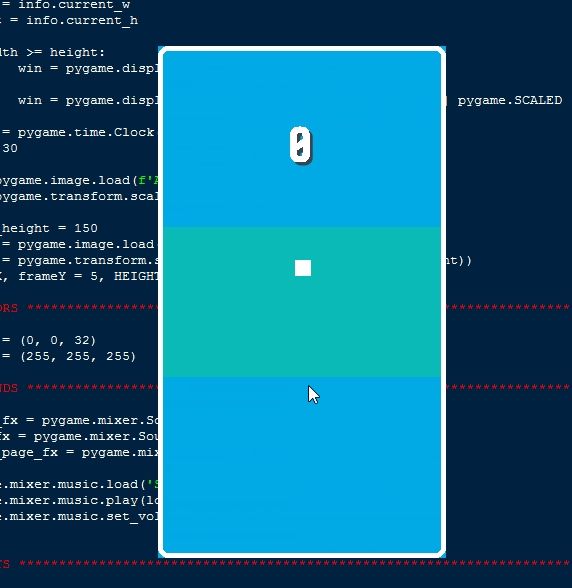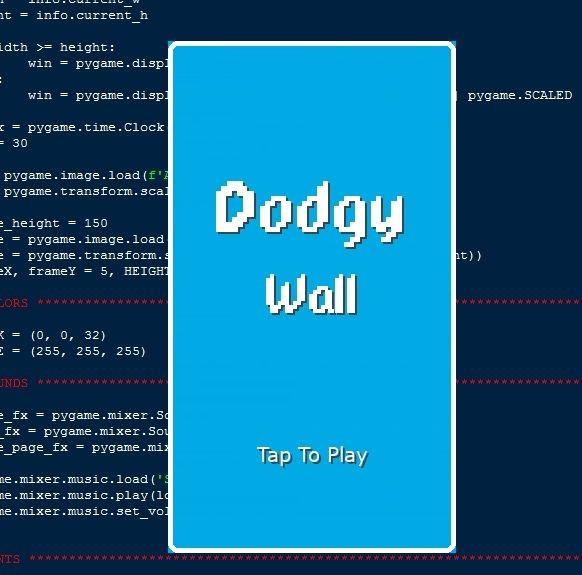Dodgy Wall Game Using Pygame in Python with Source Code
The Dodgy Wall Game is an interactive desktop application built entirely with Python using the Pygame library. The gameplay is simple yet challenging—you control the object by pressing the Left Mouse Button to change direction. The Dodgy Wall Game features straightforward mechanics where players must avoid colliding with obstacles while aiming to collect the white ball object to score points. If you hit an obstacle, the game restarts. This project offers an excellent opportunity to reinforce essential programming concepts, making it a valuable exercise for improving your Python skills in game development.
The Dodgy Wall Game Using Pygame in Python with Source Code is free to be downloaded just read the content below for more info. This application is for educational purpose only.
Dodgy Wall Game Using Pygame in Python with Source Code Basic Information
- Language used: Python
- Coding Tool used: Built-in Python IDLE
- Type: Desktop Application
- Database used: None
About Dodgy Wall Game
The Dodgy Wall Game using Pygame is an engaging and fast-paced arcade challenge where players must guide a character or object through a series of moving walls that have narrow gaps. The objective is to skillfully dodge these obstacles, avoid collisions, and survive for as long as possible while earning points with each successful pass. As the game progresses, the speed and frequency of the walls increase, testing the player’s reflexes and timing. Developed using Python’s Pygame library, it offers smooth animations, intuitive controls, and a visually appealing interface. Its simple yet addictive gameplay loop makes it a perfect example of how a straightforward concept can deliver hours of entertainment while also serving as a great learning project for those exploring game development.
Dodgy Wall Game Using Pygame in Python with Source Code Features
- Simple yet Addictive Gameplay
- Player controls a character or object that must avoid moving walls.
- Objective is to survive as long as possible without colliding.
- Fast-paced action that gets more intense over time.
- Dynamic Obstacle System
- Walls appear with varying gaps for the player to pass through.
- Randomized wall positions to keep gameplay unpredictable..
- Increasing wall speed for greater difficulty.
- Player Controls
- Smooth keyboard controls for moving up, down, left, or right.
- Responsive input to help dodge tight spaces.
- Difficulty Scaling
- Gradual increase in wall speed and spawn frequency.
- Encourages skill improvement and reflex training.
Sample Application Screenshot:



Dodgy Wall Game Using Pygame in Python with Source Code Installation Guide
- First you need to download & install the Python IDLE's, here's the link "https://www.python.org/downloads/".
- Download the source code in this site.
- Locate and Extract the zip file.
- Open the extracted folder
- Locate the py file.
- Then open the file via python IDLE or any IDE that supports python language.
- Run the py file to launch the program.
That's all, The Dodgy Wall Game was created fully functional using JavaScript language. I hope that this project can help you to what you are looking for. For more projects and tutorials please kindly visit this site. Enjoy Coding!
The Dodgy Wall Game Using Pygame in Python with Source Code is ready to be downloaded just kindly click the download button below.
Related Projects & Tutorials
Dodgy Wall GameNote: Due to the size or complexity of this submission, the author has submitted it as a .zip file to shorten your download time. After downloading it, you will need a program like Winzip to decompress it.
Virus note: All files are scanned once-a-day by SourceCodester.com for viruses, but new viruses come out every day, so no prevention program can catch 100% of them.
FOR YOUR OWN SAFETY, PLEASE:
1. Re-scan downloaded files using your personal virus checker before using it.
2. NEVER, EVER run compiled files (.exe's, .ocx's, .dll's etc.)--only run source code.

